Physical Address
304 North Cardinal St.
Dorchester Center, MA 02124
Physical Address
304 North Cardinal St.
Dorchester Center, MA 02124
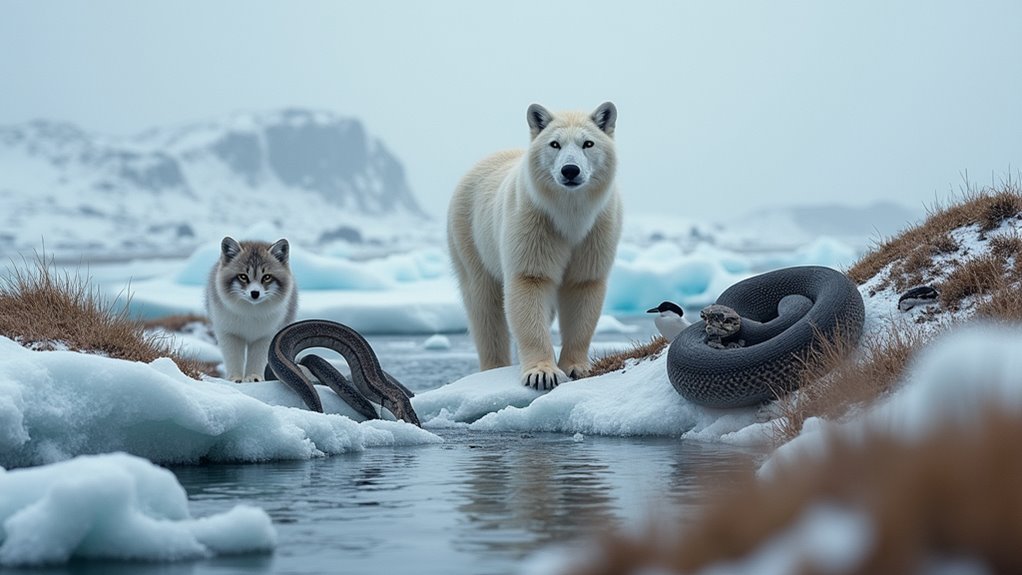
From polar bears drifting on ice to aggressive Arctic terns attacking your head, Iceland's wildlife poses surprising dangers you never expected.
Iceland’s most dangerous animals include aggressive Arctic terns that dive-bomb your head during breeding season, rare but deadly polar bears that occasionally drift from Greenland, and invasive feral mink that decimate local wildlife. You’ll also need to watch for farm animals like territorial rams, road-crossing reindeer that cause vehicle collisions, aggressive seagulls defending their nests, and crafty Arctic foxes. Exploring Iceland’s wilderness requires awareness of these surprising threats to stay safe.
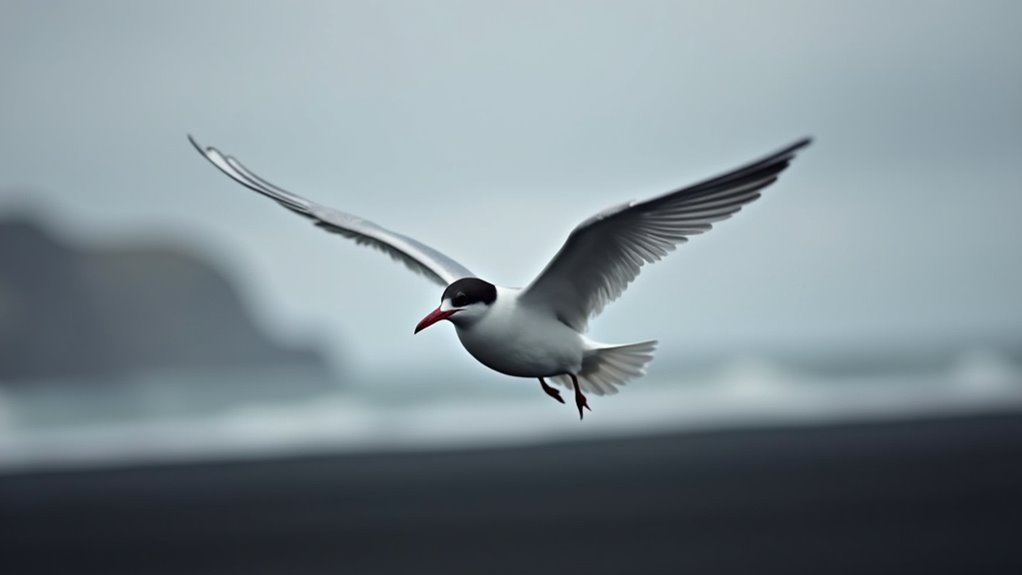
While Iceland may seem like a land without dangerous predators, the Arctic tern proves this assumption wrong. These small birds become remarkably aggressive during breeding season, fearlessly attacking anything they perceive as a threat to their nests or young.
Iceland’s fearsome defenders: Arctic terns transform from migratory marvels to aggressive attackers when protecting their breeding grounds.
You’ll recognize their distinctive “kee-kee” calls before they strike, typically aiming for your head or back. Despite their small size, their attacks can draw blood. When traveling near their habitats, holding a stick above your head can effectively distract diving birds during an attack.
If you’re hiking near coastal areas or tundra water sources during summer, beware of their coordinated colony defense tactics.
Outside breeding season, you’re safe—these birds are actually remarkable for completing the world’s longest migration, traveling from Arctic to Antarctic and back annually. Unlike the peaceful marine wildlife you might encounter while snorkeling in Dubrovnik, Arctic terns are not venomous or predatory toward humans, but their protective instincts make them Iceland’s most surprisingly dangerous aerial residents.
Unlike many of Iceland’s frightening animals, polar bears pose a rare but genuine lethal threat to humans. Since Iceland’s settlement, only about 700 sightings have been recorded, with modern encounters averaging just one every other year.
These massive predators drift from Greenland on icebergs, typically landing in northern regions like the Westfjords. While no resident population exists, visitors are usually shot for safety reasons, though some have been successfully relocated. Polar bears’ incredible thick fat layer, which can reach up to 11 cm, helps them survive the frigid Arctic waters during their journey to Iceland.
The most recent arrival occurred in 2024 when a bear reached the Westfjords via iceberg and was killed following safety protocols. Despite their vulnerable conservation status globally, Iceland prioritizes human safety when these powerful hunters appear on its shores—so you’ll likely never encounter one, but if you do, consider it an extremely dangerous situation. Tourists visiting the historic coastal areas of Iceland should be aware of the country’s polar bear protocols when exploring remote regions.
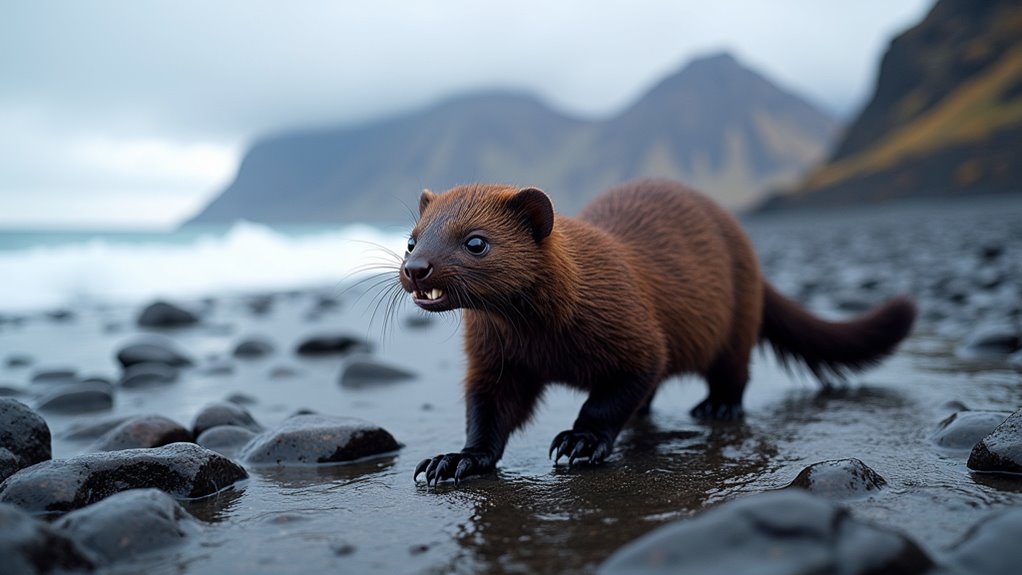
Polar bears may be rare visitors, but Iceland hosts another predator that’s firmly established itself across the country. Feral mink, descendants of fur farm escapees from the 1930s, now inhabit nearly every corner of Iceland’s wilderness.
While polar bears rarely reach Iceland’s shores, feral mink have conquered the island’s wilderness since escaping fur farms decades ago.
These adaptable hunters thrive along shorelines and waterways, feeding on littoral fish, birds, eggs, and small mammals. With impressive reproductive rates—producing up to 10 cubs per litter—they’ve had a devastating impact on native wildlife, particularly seabird colonies. These invasive predators are known to kill multiple victims at once, often leaving large puffin carcasses on beaches as evidence of their deadly efficiency.
While not directly dangerous to humans, mink have markedly altered Iceland’s fragile ecosystem. Government-sponsored hunting programs attempt to control their numbers, but these elusive predators continue to roam distances up to 55km, making eradication nearly impossible. They represent a stark contrast to the vibrant party atmosphere found in Cyprus’s popular nightlife destinations.
Their presence represents one of Iceland’s most significant invasive species challenges.
Tourists exploring Iceland’s countryside often overlook the significant dangers posed by common farm animals. Sheep, typically docile, can become aggressive when provoked, while rams can inflict serious injuries with their powerful charges.
Cows and horses represent substantial threats due to their size and strength, particularly when startled or protecting young. Even farm dogs, trained to guard livestock, may perceive you as a threat to their territory.
Weather conditions unique to Iceland can affect animal behavior, making them more unpredictable. Similar to Nordic countries, Iceland’s rural areas require visitors to exercise caution around wildlife and farm animals alike. When visiting rural areas, maintain a safe distance from all farm animals, avoid direct eye contact, and approach quietly without sudden movements.
Always respect property boundaries, watch for warning signs, and consider having a local guide when exploring unfamiliar farmland. Unlike the misconception about polar bears inhabiting Iceland, these animals only occasionally arrive on Icelandic icebergs from Greenland.
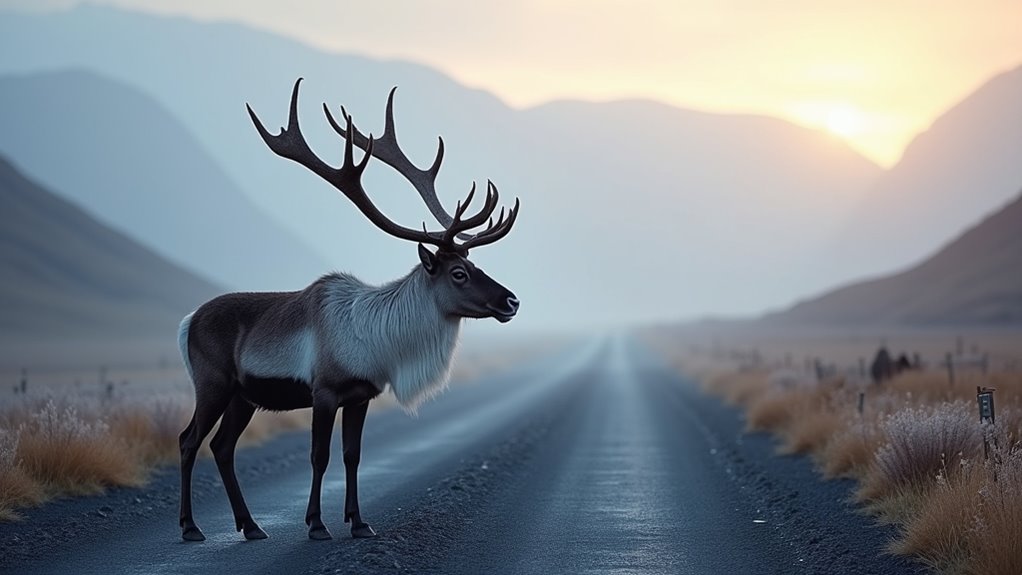
Majestically roaming the eastern highlands of Iceland, reindeer pose a significant danger to motorists, especially during their seasonal migrations. When winter arrives, these animals descend from higher elevations to coastal areas in search of food, frequently crossing roadways in the process.
You’ll need to exercise extreme caution when driving in East Iceland, particularly after dark when reindeer are difficult to spot. The construction of the Kárahnjúkar power plant has worsened this hazard by increasing traffic in previously undisturbed areas. With a population estimated at 7,000 as of last spring, these wild animals represent a substantial risk for drivers.
In 2013 alone, 13 reindeer died in vehicle collisions—the highest number since 2007.
December brings heightened risk levels as many travelers explore Iceland’s winter landscapes, further increasing the chances of wildlife encounters on rural roads. Watch for warning notifications from road administrations during high-risk periods, and remember that infrastructure development continues to disrupt their natural habitats, forcing more frequent road crossings.
During the Arctic summer breeding season, Iceland’s coastal areas become battlegrounds where seagulls fiercely defend their nesting territories against perceived intruders. You’ll encounter these aggressive birds nesting on narrow cliff ledges from late May through July, when their protective instincts are at their peak.
Don’t be fooled by their ordinary appearance—these gulls will dive-bomb you if you approach their nesting sites. They’re particularly defensive during the fledging period in late June when their chicks are vulnerable.
Both parents share defense duties, making attacks more frequent and persistent.
Their aggression extends beyond humans—they’ll steal eggs from neighboring birds and scavenge near coastal settlements. Unlike some wildlife travelers who might prefer Mediterranean destinations for animal watching, Iceland offers a unique but sometimes intimidating seabird experience. Unlike some larger gull species, these birds exhibit a graceful, low flight when searching for food along the coastline. If you’re exploring Iceland’s dramatic cliffs, maintain a safe distance from gull colonies to avoid these surprisingly intimidating coastal attackers.
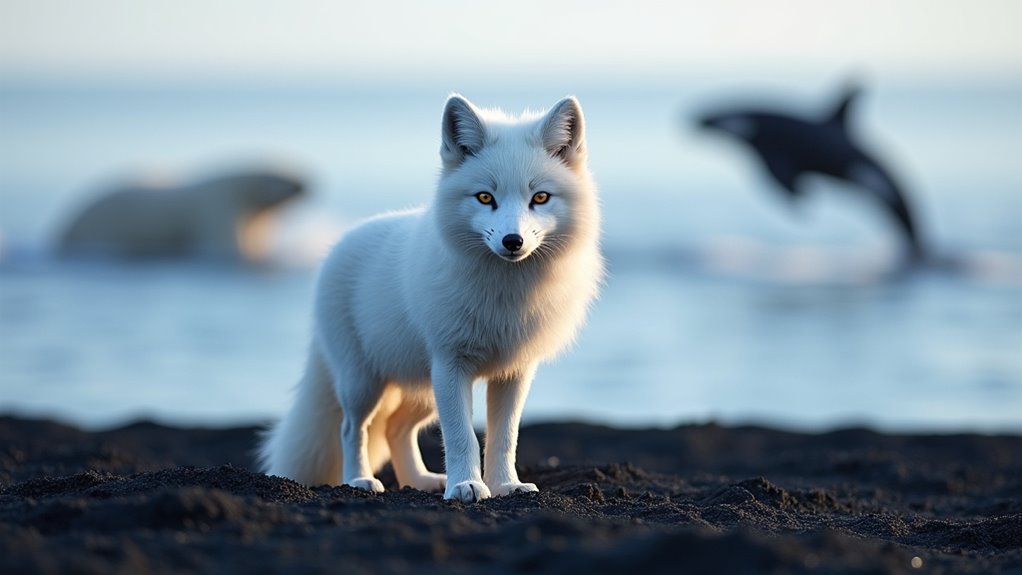
While most of Iceland’s mammals were introduced by humans, the Arctic fox functions as the island’s only native land mammal. Having arrived approximately 10,000 years ago by crossing frozen seas from Scandinavia and Greenland, these small predators are known as “melrakki” in Icelandic.
Iceland’s native Arctic fox traveled across frozen seas millennia ago, earning the Icelandic name “melrakki”
You’ll find the highest concentration of Arctic foxes in the bird-rich Westfjords, particularly in Hornstrandir’s protected area. Despite their estimated population of 7,000, their numbers are declining. Unlike nearby Sweden’s wildlife attractions, Iceland offers a unique opportunity to observe these rare creatures in their natural habitat.
Though they lack natural predators besides humans, hunting is permitted outside nature reserves. Farmers often view them as pests due to their predation on livestock. These remarkably resilient creatures can survive in temperatures as low as negative fifty degrees Celsius.
Their diet primarily consists of seabird eggs and chicks, though they’ll opportunistically consume berries, small mammals, and carrion when available.
Iceland’s untamed creatures mirror life’s unexpected challenges. You’ll find danger where you least expect it—not just from the wild polar bears that rarely visit, but from the seemingly innocent farm animals that pose greater risks. Like these creatures, the threats you face aren’t always the most obvious ones. Stay vigilant, respect nature’s boundaries, and you’ll safely navigate both Iceland’s wilderness and life’s hidden perils.